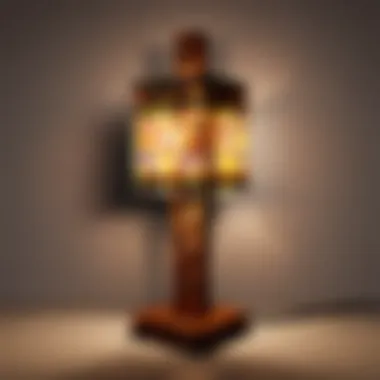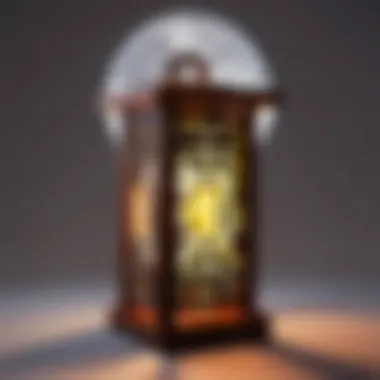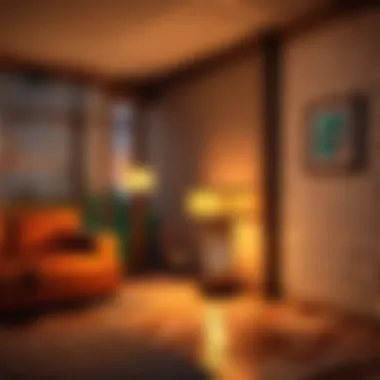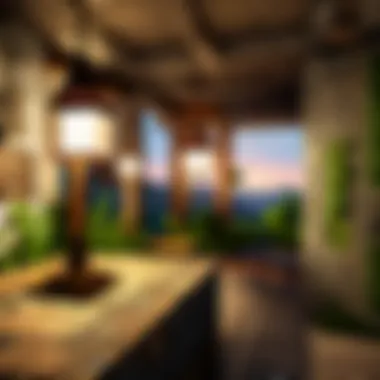Exploring Minecraft Lamps: Functionality & Aesthetics


Intro
In the expansive universe of Minecraft, players are often absorbed in the vast possibilities for creation and exploration. Among these creative tools, lamps hold a unique position. Their functionality extends beyond mere illumination; they are fundamental for enhancing gameplay and fostering player ingenuity. Understanding lamps involves examining their diverse types, crafting methods, and the role they play in in-game navigation. Furthermore, their aesthetic contribution can markedly transform the atmosphere of player-crafted environments.
Through this discussion, we will guide players in better comprehending how to utilize lamps effectively. This will encompass both practical applications and the design choices that can elevate a player's creations.
Minecraft Game Guides
Crafting Recipes Encyclopedia
Lamps in Minecraft are not only important for lighting but also for crafting engaging spaces. Players can create various types of lamps, each providing unique benefits:
- Glowstone: Obtained from the Nether, it emits strong light.
- Sea Lantern: Crafted from Prismarine Shards and Crystals, it offers an oceanic aesthetic.
- Redstone Lamp: Functionally unique, requires a Redstone signal to activate.
Crafting lamps can greatly affect how players design their builds. By learning the recipes, players often discover innovative designs and solutions to lighting needs.
Building Techniques Tutorial
Effective lamp placement can dramatically enhance the look and feel of a structure. Here are some tips for integration:
- Layered Lighting: Using different types of lamps together can create depth.
- Hidden Light Sources: Conceal lamps behind blocks to create a soft glow.
- Path Lighting: Strategically place lamps along pathways to guide exploration.
This not only improves functionality but also adds sophistication to designs. Clever lighting choices can help define space and create mood.
Redstone Mechanics Explained
Redstone lamps, in particular, open a world of possibilities in creating systems for automation and smart structures. The ability to control them via Redstone provides:
- Variable Lighting: Players can create rooms that adjust brightness with an automatic mechanism.
- Interactive Builds: Integrate lamps with switches or sensors for dynamic responses.
- Signal Flexibility: Understanding Redstone can lead to complex setups where lighting serves a larger purpose.
This technical aspect of lamp functionality can greatly enhance gameplay, offering players the chance to integrate engineering with artistry.
Latest Updates and Patch Notes
In the ever-evolving game of Minecraft, keeping abreast of updates is crucial for enhancing your gameplay.
New Features Analysis
Recent patches focused on improving the mechanics surrounding lamps. Features like:
- Improved light propagation mechanics
- New decorative block options adjacent to lamp designs
…have redefined how players approach lighting within their builds, allowing for new creative expressions.
Finale
By understanding the diverse types of Minecraft lamps and their crafting methods, one can fully leverage their potential. The interplay between functionality and aesthetics in lighting solutions can significantly enhance a player’s experience and creativity. As players refine their in-game lighting techniques, they can create captivating spaces that are both beautiful and practical. For those looking to embrace this aspect of Minecraft, the journey of exploration and experimentation never truly ends.
Understanding Minecraft Lamps
In the universe of Minecraft, lamps serve as vital tools for both functionality and aesthetics. These simple yet effective light sources create a welcoming atmosphere while fulfilling strategic roles in gameplay. Understanding how lamps operate is crucial for players who wish to enhance their building experience and optimize their survival tactics. Proper lighting not only illuminates dark spaces but also contributes to the overall design of constructions, making them more visually appealing.


Understanding Minecraft lamps involves exploring their definitions, historical context, and various types. Each lamp offers unique features and crafting processes. Players often grapple with the thought of which lamps to use under specific circumstances to achieve a practical and visually pleasing result. Knowing the variety of lamps available can significantly influence a player’s approach to building and exploring.
Definition of Lamps in Minecraft
In Minecraft, lamps are artificial light sources crafted from specific materials. They illuminate the environment and help prevent hostile mobs from spawning, making them essential in survival mode. The game features a variety of lamps that cater to different uses and aesthetics, allowing players flexibility in their designs. While some lamps emit light continuously, others can be turned on and off depending on player needs.
Understanding these definitions provides players with the knowledge to choose the appropriate lighting solution in different scenarios, from illuminating a vast castle to creating a cozy village.
Historical Development of Lighting Tools
The evolution of lighting tools in Minecraft reflects broader changes in the game's mechanics and player creativity. Initially, torches were the only lighting source available, easily crafted and readily accessible. As the game evolved, so did the selection of illumination options. Adding blocks such as glowstone and sea lanterns enriched the game, providing new tactical and design opportunities.
Each update introduces innovations, such as the introduction of redstone lamps that connect to power sources. This allows for intricate lighting systems that can be controlled and modified. The historical development of lighting tools in Minecraft not only showcases the game’s growth but also inspires players to think creatively about how they use light in their structures.
Types of Lamps in Minecraft
Lamps serve a critical function within the vast landscape of Minecraft, and understanding their various types is essential for players looking to enhance their gameplay and environment design. Each type of lamp not only fulfills the basic need for illumination but also brings unique benefits and aesthetic qualities. This section illuminates the different varieties of lamps available, examining their distinct characteristics, utilities, and crafting requirements. By knowing these elements, players can make informed choices in their builds and optimize their experience in the game.
Torch: The Foundation of Lighting
Torches are perhaps the most recognizable and foundational lighting tool in Minecraft. They require only simple materials: a stick and a lump of coal or charcoal. When placed, torches provide light level 14, making them ideal for illuminating vast areas.
One key aspect of torches is their versatility. They can be mounted on walls, floors, or ceilings, offering flexible placement options. Players often rely on torches to deter hostile mobs from spawning in certain areas, which is critical for maintaining safety.
However, while torches are effective, they can be limited in terms of aesthetic appeal. When used exclusively, they can create a somewhat utilitarian look. Thus, players may consider integrating other lamp types for more visually diverse environments.
Glowstone: A Unique Resource
Glowstone is a valuable resource known for its striking appearance and high light output. It emits a light level of 15, making it one of the brightest light sources. Players obtain glowstone by mining it from the Nether, which adds an additional layer of exploration and resource management to its usability.
Beyond illumination, glowstone is also a sought-after decorative element. Its bright color stands out in a variety of settings, making it a favorite among builders looking to add a touch of vibrance. However, acquiring glowstone often requires venturing into dangerous territory, as the Nether is filled with hostile mobs. This risk adds to the allure of glowstone, appealing to players who seek challenge and reward.
Sea Lantern: Underwater Illumination
Sea lanterns, crafted with prismarine and shards, serve as a unique light source primarily used in underwater builds. They emit a light level of 15, comparable to glowstone, but have a distinct blue hue that fits perfectly within aquatic environments.
A notable advantage of sea lanterns is their capability to prevent the spawning of hostile mobs, making them advantageous for underwater exploration. Their visually appealing look complements ocean-themed builds and promotes creative design. Incorporating sea lanterns can enhance the aesthetic coherence of structures submerged in water. This element of design consideration makes sea lanterns valuable not just for functionality, but for artistic expression as well.
Redstone Lamp: A Technical Marvel
Redstone lamps highlight the intersection of functionality and technology within Minecraft. Used primarily in redstone contraptions, these lamps can be toggled on and off using redstone circuits, enabling players to control their lighting precisely. This feature allows for more sophisticated designs in terms of lighting control — a serious advantage for advanced builders.
The crafting process does require a redstone dust component along with a glowstone block, which adds a degree of complexity. Nevertheless, for players aiming to elevate their builds through automation and smart technology, redstone lamps are a commendable choice. Their unique functionality promotes creative exploration and innovative builds that go beyond basic illumination.
Lantern: Aesthetic and Practical
Lanterns provide a beautiful lighting solution that successfully marries practicality with aesthetics. They can be crafted using iron nuggets and torches, making them relatively easy to obtain. The light they emit is level 15 when hung, making lanterns quite effective for lighting needs.
The design of lanterns is charming and fits various architectural styles. When placed, they add a rustic or cosmopolitan feel, enhancing existing builds without overwhelming the space. Lanterns can be hung or placed on surfaces, providing flexibility in both exterior and interior design. They are particularly popular in villages, allowing for beautifully illuminated homes and streets. Overall, their blend of form and function makes them a valuable addition to any player's lighting arsenal.
Crafting Mechanisms


Understanding the crafting mechanisms in Minecraft is critical for any player who wants to maximize their use of lamps. As the essential tools for generating light, lamps are built through unique crafting recipes that vary depending on their type. Mastering these crafting techniques not only enhances gameplay but also broadens the player's creative possibilities. In this section, we will explore the detailed processes involved in creating different types of lamps, as well as the materials required. The knowledge gained here will enable players to develop effective lighting solutions in their builds, thereby improving both functionality and aesthetics.
Crafting Torches: Basic Materials
Torches serve as the most fundamental light source in Minecraft. To craft a torch, players need two key components: coal and sticks. Coal can be obtained through mining, while sticks can be crafted from wooden planks. To make a torch, position the coal above the stick in the crafting grid. This straightforward process allows players to quickly and efficiently light up caves, homes, and paths.
Glowstone Crafting Procedures
Glowstone is an exquisite light source characterized by its bright, luminous appearance. Players can collect glowstone dust by mining glowstone blocks, which can be found in the Nether. To craft a glowstone block, arrange four glowstone dust in a square format within the crafting table. This block can then be broken down into glowstone dust again, providing flexibility in usage.
Creating Sea Lanterns
Sea lanterns present another stunning light option, perfect for underwater builds. To create a sea lantern, players must gather prismarine shards, which can be obtained from guardians or mined from ocean monuments. The crafting process requires four prismarine shards and a prismarine crystal, arranged in a cross design on the crafting grid. This yields one sea lantern that emits a soft, yet radiant glow, contributing to beautiful underwater vistas.
Building Redstone Lamps
Redstone lamps blend light with technology, allowing for dynamic lighting solutions. Crafting a redstone lamp involves materials like glowstone and redstone dust. Place one glowstone block in the center of the crafting grid, surrounded by four redstone dust. This lamp can be toggled on and off using redstone circuits, making it versatile for various practical applications.
The Art of Making Lanterns
Lanterns offer an aesthetic appeal alongside functional lighting. To build a lantern, gather iron nuggets and a torch. Arrange the iron nuggets to form a cube-like pattern around the torch in the crafting table. This results in a lantern that hangs beautifully from ceilings or can be placed on surfaces. Players appreciate lanterns not only for their warm glow but also for their design flexibility in themed builds.
Functional Uses of Lamps
In the context of Minecraft, lamps serve several critical functions that extend beyond mere decoration. They are indispensable tools for players who aim to create well-lit, safe, and visually appealing environments. Understanding the functional uses of lamps enables players to make informed decisions about their construction and lighting strategies. The importance of this topic lies in empowering players to harness the full potential of lighting mechanisms to enhance gameplay and optimize their builds.
Illuminating Pathways
One of the primary uses of lamps in Minecraft is to illuminate pathways. When players venture into expansive worlds, navigating through darkened areas can be hazardous. Strategic lamp placement along paths significantly enhances visibility, guiding players safely through their landscapes. Using torches, lanterns, or glowstone, players can create well-lit trails that not only provide safety but also aesthetic appeal. Furthermore, well-lit pathways help other players, in multiplayer environments, easily navigate a community space.
Mob Prevention Techniques
In Minecraft, darkness serves as a spawn point for various hostile mobs. To mitigate this risk, effective lamp installation serves as a preventative measure. By ensuring that areas are adequately lit, players can inhibit mob spawns and maintain a secure gaming experience. This involves placing lamps at strategic intervals around structures, farms, and other key locations. Understanding the light level mechanics is essential in this aspect. For instance, maintaining a light level of 8 or higher in essential areas can prevent creatures like zombies and skeletons from emerging.
Aiding Exploration
Exploration is an integral part of the Minecraft experience. Players often venture into caves, forests, or uncharted territories, which can quickly become disorienting without proper lighting. Lamps serve as crucial tools for marking explored areas and providing insight into nearby resources. By placing sea lanterns or redstone lamps across their path, players can create a visual map that guides them back home or to resource-rich zones. Additionally, illuminating caves can reveal valuable ores and hidden treasures, thus aiding in resource collection.
Enhanced Farming Efficiency
Farming is a vital component of Minecraft gameplay and requires correct lighting for optimal efficiency. Many plants, such as crops or melons, have specific light requirements to grow. Utilizing lamps can enhance growth rates significantly. Effective placement of lamps, like glowstone or lanterns, near farming areas ensures that crops receive sufficient light to grow, even during the night. This leads to an increased yield and provides players with a sustainable food source, reducing the need for constant foraging for food.
"Lighting is not just a necessity; it can be a fundamental strategy in Minecraft for enhancing safety, navigation, and productivity."
By understanding the functional uses of lamps in Minecraft, players can elevate their gameplay. It allows them to cultivate safer environments, navigate effectively, and optimize their farming practices.
Aesthetic Considerations
The aesthetic value of lamps in Minecraft goes beyond mere illumination; it contributes significantly to the overall experience of building and exploring in the game. Players often face the challenge of balancing function with beauty in their structures. Aesthetic considerations in lamp design allow players to create environments that are not only practical but also captivating. When thoughtfully integrated, lamps can transform a cold, sterile space into a warm and inviting one.
Designing Player-Constructed Environments


When designing player-constructed environments, lighting serves as a crucial element. A well-placed lamp can enhance the visual flow of a room or outdoor area. Consideration of style is essential; different lamps have unique appearances that can fit various themes, from rustic to sleek modern designs. For example, using torches can evoke a cozy, medieval feel, while sea lanterns can add a sleek, futuristic edge.
In addition, lamps are central to establishing moods within a build. Players can manipulate light intensity and color to create different atmospheres. This is particularly effective in communal spaces or themed builds where conveyance of a specific vibe is paramount.
The Role of Color in Lighting
Color plays a significant role in the way lamps affect the perception of space. The Minecraft palette offers a variety of colors through different lighting options. Players often choose lamps based on their color properties allowing for richer environments. For instance, warm colors like red and yellow can create inviting spaces, while cooler colors can suggest serenity.
When utilizing glowstone or stained glass, the combination of colors can yield interesting effects on nearby blocks. Additionally, redstone lamps can be powered and turned on or off, allowing for dynamic color applications in builds.
"Lighting can affect player emotions and interactions. A thoughtful color scheme may engage players deeper into gameplay."
Integrating Lamps into Landscape Design
In landscape design, lamps help to highlight features and pathways. Lighting can guide players through vast terrains, enhancing the exploration experience. Using different lamps along walkways can create visual cues leading to important locations such as towns, farms, or hidden treasures. This not only aids navigation but can cultivate a sense of adventure.
Furthermore, integrating lamps with natural elements like trees or rocks creates cohesion between construction and nature. Lanterns hung from branches or glowstone embedded in cliffs can mix the artificial with the natural beautifully.
In summary, aesthetic considerations for Minecraft lamps play a pivotal role in crafting immersive environments. From designing spaces to understanding the impact of color and effectively integrating lamps into landscapes, players can significantly enrich their Minecraft experiences.
Strategic Lighting Tips
Lighting in Minecraft is not just a matter of visibility; it plays a crucial role in gameplay and overall aesthetic. Strategic lighting can enhance safety, facilitate exploration, and contribute significantly to the overall design of a player’s environment. Proper lighting choices can prevent mobs from spawning and create welcoming atmospheres in builds. Understanding strategic lighting is essential for players invested in both the functional and aesthetic aspects of their Minecraft experience.
Best Practices for Efficient Illumination
Efficient illumination encompasses various practices that allow players to maximize light without wasting resources. Here are several essential tips:
- Utilize Multiple Lamp Types: Different lamps emit varying light levels. Combining torches, glowstone, and lanterns can create a balanced lighting system.
- Layer Your Lights: Placing lamps at different heights can add depth and character to the space. Consider the ambient light as well, using items like glass to diffuse light effectively.
- Spacing and Density: Ensure that lamps are spaced correctly to avoid dark spots. A common rule is that light should be placed no more than 10 blocks apart to keep areas well-lit.
- Plan Your Light Sources: Before starting placement, plan where your lamps will go. Mapping out the area helps avoid unnecessary backtracking and adjustments later on.
Using these best practices, players can greatly improve lighting efficiency throughout their builds.
Adjusting Lamp Placement for Tactical Advantage
Placement of lamps is not merely about aesthetics; it can provide tactical benefits in gameplay. The right positioning can lead to improved safety while exploring or farming. Here are some considerations for tactical adjustments:
- Strategic Locations: Place lamps near entrances to homes and farms. This deters hostile mobs and makes navigation easier during night or dark conditions.
- Pathway Lighting: Use lights along pathways to guide yourself and other players. This guides the way and marks important areas, enhancing exploration.
- Illuminating High-Risk Areas: Ensure that caves or fields where mobs often spawn are well-lit. This can significantly reduce the risk when exploring or engaging in activities like farming.
- Dynamic Adjustments: Don’t hesitate to move lamps as needed. During gameplay, observe areas that still feel too dark or unsafe, and adjust the lamp positions accordingly.
"Illuminating your surroundings not only enhances visibility but also provides peace of mind in an often unpredictable game environment."
By following these lighting strategies, players can tailor their environments for both beauty and practicality, creating a more enjoyable Minecraft experience.
Closure and Future Trends in Minecraft Lighting
The significance of lamps in Minecraft transcends mere illumination. As players traverse the intricate landscapes of this blocky universe, lighting becomes an integral aspect of both functionality and stylistic choices. In assessing the current trends and potential developments in Minecraft lighting, one can grasp how these elements shape gameplay and community engagement.
Emerging Lamp Designs in Updates
Recent updates in Minecraft have introduced several new lamp designs that showcase the game developers’ dedication to enhancing aesthetic diversity. For instance, the introduction of the Soul Lantern brought a unique blue hue to in-game lighting options. This lamp not only provides illumination but also adds a distinct mood to environments, enhancing thematic builds, especially in spooky or mystical settings.
"Emerging designs in Minecraft lamps allow players to express creativity and captivate their audiences through lighting choices."
Players can look forward to even more innovative lamp types in future updates. The community has been active in suggesting whimsical lighting designs inspired by real-world elements. These concepts often emphasize energy efficiency or certain themes, such as nature-inspired lamps. The adaptability of lamp designs enriches the overall gaming experience and encourages players to explore new builds, which can lead to elaborate lighting schemes.
Potential for Customization and Modification
Customization remains a cornerstone of the Minecraft experience, and lamps are no exception. Players have the ability to modify existing lamp types using Redstone, which opens avenues for unique automated lighting systems. Imagine a farm filled with Redstone lamps that turn on at night and off at daytime, streamlining farming operations while enhancing productivity.
Moreover, with the rise of modding communities, numerous custom plugins are available. These allow for deeply personalized lighting solutions. Players are experimenting with colors, light intensity, and activation mechanisms. This degree of customization means that lamps can adapt dynamically to the player’s desires, enhancing immersion and personal investment in their builds.



